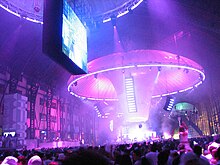Dance party
 From Wikipedia - Reading time: 10 min
From Wikipedia - Reading time: 10 min
This article has multiple issues. Please help improve it or discuss these issues on the talk page. (Learn how and when to remove these messages)
|

A dance party (also referred to as a dance) is a social gathering where dancing is the primary activity. Some dance parties are held in a casual setting and open to the public, such as a rave, or those held in nightclubs.
Other types of dance parties may be a formal or semi-formal private event which often require guests to don formal wear and have an invitation or membership within the community hosting the event, such as school dances and cotillions.
Guests of formal dances often attend in pairs, as consorts or "dates" for one another. The term "stag" refers to going without a consort to a dance organized for couples.[1] Dances commonly take place during the evening, although some are held earlier during the daytime; such events are known as tea dances.
Casual dances
[edit]Casual dances are dances that do not have a formal dress requirement; these may include school and community events, raves, evening entertainments provided for guests aboard a cruise ship, and events organized for certain holidays, such as Halloween and Mardi Gras.

School dances
[edit]A school dance is a dance sponsored by a school, and may be casual or formal. Casual school dances were originally limited to Western countries, although schools in other countries[where?] are beginning to adopt such events.[as of?] There are some schools, such as Arlington High School in Arlington, Massachusetts, that prohibit school-hosted dances, citing sex and alcohol problems.[2]
In the United States
[edit]One of the most significant school dances is prom, a relatively formal event normally reserved for Junior grade and Senior grade students. Some schools host a winter formal, a similar event, for the lower grades. In the 1950s, informal school dances in the United States were often called sock hops. The traditional Sadie Hawkins dance may be formal or semi-formal.
Live band dance
[edit]A live band dance is an event where the means of serving the dancefloor involves the use of a live band. Before the rise of discothèques and DJ-based dancefloors with recorded music (prior to the 1950s), live bands were the ubiquitous means of serving the dancefloor.[3] Along with that, slow-dancing was the primary method of dancing at the time. However; the rise of Rock and Roll music initially made it hard for people to dance when it was popularized in the early 1950s, however people quickly adapted to it and started dancing at higher speeds almost coinciding the rise of DJ-based dancefloors. Live bands have quickly been displaced by DJ-based dancefloors as the DJ stands took up less space than bandstands and that it played recorded music.[citation needed]
Ambience
[edit]
Dance parties are usually held at night, and may be hosted in private homes, bars,[4] gymnasiums, nightclubs, community centers, ballrooms, or other large open spaces suitable for use as a dance floor by many people simultaneously.
The music at dance parties is usually played through a PA system or a more powerful sound system, and is often supplied by a DJ who selects and plays pre-recorded songs from vinyl records, compact discs or with a laptop; however, some dance parties feature live instrumentalists or musicians playing their music live on an instrument, or with a laptop. Raves and other large,[quantify] modern dance parties use visual and lighting effects, such as strobe lighting and smoke machines.
Popularity
[edit]In the Jewish community, Bar and Bat Mitzvah celebrations often involve dances.[5]
Dances are common for Quinceañeras,[6] sweet sixteen parties and débutante celebrations. Some of these coming of age events involve a father-daughter dance.
Nurai, a nightclub in Beirut hosted a party event on the 28th August 2017 and by August 30, 2017 it broke the Guinness World Record for hosting a 56-hour long party to show that "it is the best party city in the world!"[7][8]
In Australia, dance parties are popular amongst teenagers, to the point that many dance parties are held specifically for teenagers in nightclubs or other locations which allow underage guests, who are usually unable to attend such places due to local laws.[9]
Specialized events
[edit]Some dance events may put an emphasis on certain genres of dance. For example, an event may feature swing or square dancing rather than dancing in general. A masked ball is a type of costume party that features dancing. Dance parties at which people mainly dance Tango are called Milongas.
See also
[edit]- Ball
- Dance hall
- Play party (United States)
- Dance music
- Barn dance
- Category:Dance festivals
- Category:Partner dance
References
[edit]- ^ "go stag - Idioms". The Free Dictionary. Farlex. Retrieved 30 September 2011.
- ^ Gregoire, Carolyn (2011-11-30). "Should Schools Ban Dances Because Of Grinding?". Huffington Post.
- ^ Borgerson, Janet; Schroeder, Jonathan (October 19, 2021). Designed for Dancing: How Midcentury Records Taught America to Dance. MIT Press. p. 21. ISBN 978-0262044332.
- ^ "September dance party". minus18.org.au. 2008-08-04. Archived from the original on 2008-12-26. Retrieved 2009-01-17.
- ^ "Tips for avoiding teen party disasters". Deseret News. New York. May 18, 2009. Archived from the original on June 19, 2009. Retrieved 16 November 2010.
- ^ de la Cova, Tony (November 30, 2008). "Quinceañera Festivity". Retrieved 16 November 2010.
- ^ H, Grace (September 2, 2017). "Lebanon Breaks Guinness World Record For Hosting The Longest Party In The World!". The 961. Retrieved September 4, 2017.
- ^ "Beirut To Break The Record For World's Longest Continuing Party At 56 Hours". A Separate State of Mind. Retrieved September 4, 2017.
- ^ Lygopoulos, Anna (2007-10-19). "Minors on licensed premises". Consumer Affairs Victoria. Archived from the original on 2008-07-23. Retrieved 2009-01-18.
 KSF
KSF